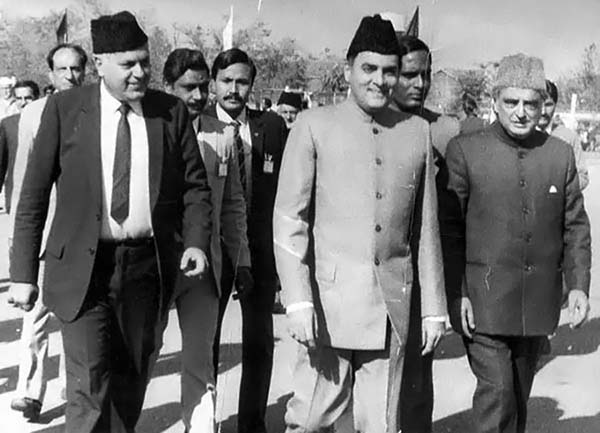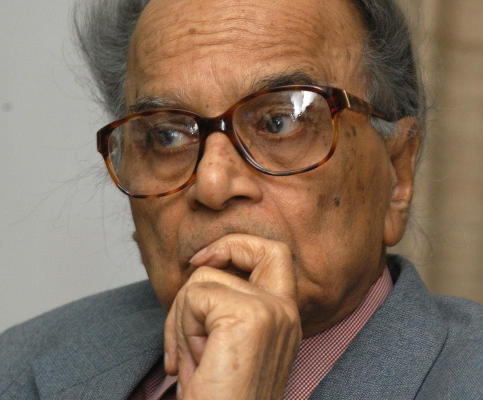
Rajiv Gandhi flanked by Dr Farooq Abdullah and late Mufti Mohammad Sayeed .Pic: Internet
Srinagar: It will be the eighth time governor rule would be imposed in Kashmir.
Once again the political machinations from New Delhi have played active part in subverting the same ‘democracy’ of which it is proud of in Kashmir. It leaves no stone unturned to make believe the world that UN resolutions on right to self determination were ‘obsolete,’ ‘old’ and can’t be held implemented because people in Kashmir are “ruling themselves”.
Yet, New Delhi resorts to political machinations according to its will and timing. Does ‘peoples rule’ exist in Jammu and Kashmir?
As the right wing Hindu Bhartiya Janta Party BJP pulled out from the ruling alliance with Peoples Democratic Party, it paved the way for the Presidents rule in the state of Jammu and Kashmir eighth time since 1977.
Hence, the governor NN Vohra is all set to rule the state for the fourth time since the year 2008.

Governor NN Vohra has ruled the state four times
Looking back at the history, the first such governor rule was imposed in the state in the year 1977 during the tenure of Governor L K Jha when the Congress had withdrawn support from the National Conference led government headed by Sheikh Abdullah.
Political analysts believe that it was a plan by the then Prime Minister Indira Gandhi to discredit NC president Sheikh Abdullah by first supporting him to cling to power, then suddenly withdrawing the support.
Similar to what happened on Tuesday when BJP withdrew support to PDP leaving them frustrated and speechless.
In March 1986, as Sheikh Abdullah’s son in law Ghulam Mohammad Shah was ruling the state for almost 2 years since July 1984, the federal government in Delhi led by the Congress party imposed governor rule in the state.
That time Congress government cited law and order problems in the state as a reason to recommend governor’s rule and sent Jagmohan Malhotra as the Governor.

Governor Jagmohan Malhotra
During the end of same year, the then Prime Minister Rajiv Gandhi formed an accord with Farooq Abdullah to share power in the state.
1987-88 elections were rigged by the National Conference and Congress coalition. This led to the mass uprising and the defeated candidates were the first to pick up the gun and launch an armed struggle against Delhi’s rule.
In 1990, the NC led government was dismissed by Delhi and the state was put under once again under governor rule.
Jagmohan who was sent as governor returned to the Raj Bhavan and was tasked to crush the popular rebellion. It was during his time, Kashmir witnessed exodus of Pandits to Jammu and major massacres during which government forces opened fire on mass protesters killing dozens of them.
The Governor’s ’s rule imposed in 1990 continued for six years and eight months, as holding elections due to the scale of violence in the valley had become almost impossible.
It was the longest period in the history of Jammu and Kashmir to be ruled by the federal government.
According to political analyst Noor Mohammad Baba the governor’s rule extended for six long years because no one was willing to contest elections at that time.
“Hardly any people were willing to contest the election, so it was more of a compulsion then,” Baba explained.
Governor’s rule had to be imposed in the state for the fourth time in October 2002 after the then Chief Minister Farooq Abdullah refused to continue in the office in the wake of his party’s defeat in the assembly elections that year.
The stint lasted only for 15 days only as the newly emerged PDP cobbled up an alliance with Congress and 12 other independent candidates to form the goverenment.
Then again governor’s rule was imposed in the state in 2008 after the PDP withdrew support to Ghulam Nabi Azad-led Congress-PDP coalition government in July 2008 following widespread protests over Amarnath Land transfer.
The clashes between the protesters and the forces including police during that period left 80 civilians dead and hundreds other injured.
The governor rule continued in the state for 174 days.
The governor’s rule came to an end on January 5, 2009 after NC Vice president Omar Abdullah was sworn in as the youngest Chief Minister of the state.
In 2015, the governor’s rule was again imposed in the state after the assembly election results on December 23threw up a hung assembly with no party or combination of parties able to stake claim for government formation.
That time the PDP emerged as the single largest party with 28 seats in the 87-member. BJP was close second with 25 seats followed by National Conference (15 seats), Congress (12 seats) and others (seven seats).
The governor’s rule lasted for almost 3 months ending on March 1 after PDP and BJP the two ideologically different parties cobbled up to form an alliance.
They formed an Agenda of Alliance and called it “coaliation dharma” and late Mufti Mohammad Sayeed was elected as the chief minister of the state.
Less than a year later, governor’s rule was imposed in the state for seventh time (Fourth by Vohra) with effect from January 8, 2016, when the then chief minister Mehbooba Mufti had shown reluctance to form the government with BJP following the death of her father Mufti Mohammad Sayeed.
With the process of a new government formation in Jammu and Kashmir following the death of Mufti Sayeed, the state was placed under governor’s rule.
The rule lasted for four months till April 06, 2016 when finally Mehbooba Mufti was sworn in as the chief minister of Jammu and Kashmir.
Experts believe that the main reason for imposing governor’s rule has been due to the instability in the state.
Political analyst Noor Mohammad Baba believes imposition of the governor’s rule is not unique to Jammu and Kashmir only.
“However the frequency at which it has been imposed in the state is unique,” he said.
“It happens in other states too. However the frequency of the imposition of rule has increased in the valley due to abnormal situation since the early 1990s when armed rebellion against Indian rule erupted in Kashmir”.
Law professor and columnist, Sheikh Showkat Hussein, believes that the frequency of imposition of governor’s rule in the state has increased because political system in Jammu and Kashmir lacks legitimacy.
“There is a deficit of trust between the people and the system. On account of it the state remains unstable and sandwiched between expectations of New Delhi and grievances of people of the state,” Hussein said.
How governor’s rule is imposed in Kashmir?
Unlike other states, the imposition of Governor’s rule in the state is slightly different.
In other states, the President’s rule is imposed under the Article 356 of Constitution of India while in J&K, Governor’s rule is mentioned under Article 370 section 92.
As per Section 92 of state Constitution, the Governor’s Rule can be imposed for a period of six months in the state. .
Governor’s Rule can be imposed only after the consent of the President of India in case of failure of constitutional machinery.
During the Governors rule, state Assembly is either suspended or dissolved and the state completely comes under direct Central rule.
If the Constitutional machinery in the state is not restored before the expiry of this six month period, the provisions of Article 356 of the Constitution of India are extended to J&K and the President’s rule is imposed in the State.
